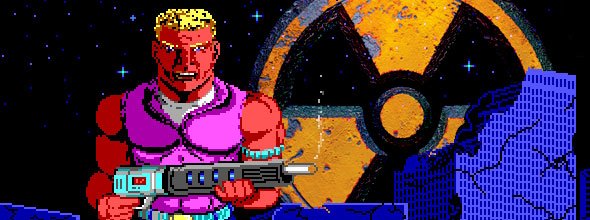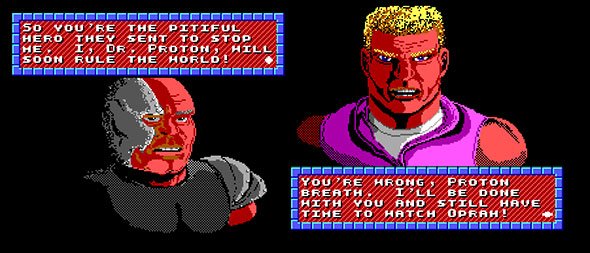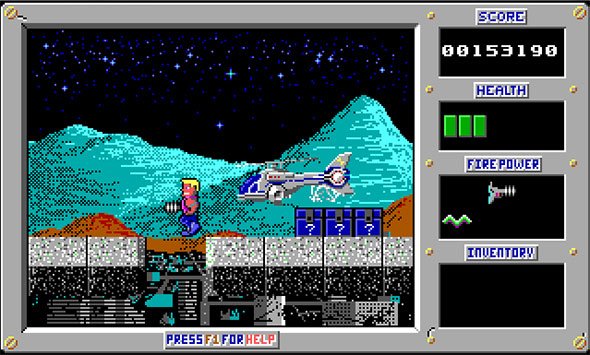Crapshoot: The original Duke Nukem, who just wanted to be home in time for Oprah
We're rerunning Richard Cobbett's classic Crapshoot column, in which he rolled the dice and took a chance on obscure games—both good and bad.

From 2010 to 2014 Richard Cobbett wrote Crapshoot, a column about bringing random obscure games back into the light. In this special Before They Were Infamous edition he returns to the dark days when nobody really took the PC seriously as a gaming platform.
Looking back, it's almost impossible to comprehend just how fast PC games moved in the early 90s. The original Duke Nukem came out in 1991. Duke Nukem 3D came out in 1996. That's five years to go from a simple 2D side-scroller to full, multilevel 3D worlds that at least took a crack at recreating the real world. It's five years in which Duke went from a generic platform game character—who almost got renamed over fears that he might be mistaken for a Captain Planet villain—into the poster-boy for adolescent power fantasies.
It's safe to say that when the first game came out, nobody would have predicted the world would ever spend years on tenterhooks, waiting for his next adventure. After all, when's the last time you heard anyone talk about the far more popular Commander Keen, or other contemporary characters like Johnny Dash, Major Stryker, Snake Logan or Mylo Steamwitz? Come on, you know Mylo! From Crystal Caves?
The original Duke Nukem definitely isn't an obscure game as such. Most people are at least dimly aware that the series didn't start with Duke Nukem 3D, and initially that game shipped with both the original and its sequel (the unsurprisingly named Duke Nukem II) on the CD. However, chances are most people haven't played it. This week then, we're going back to before anyone knew to bet on Duke.

Pink shirt. Fuzzy hair. Just wanted to get home and watch Oprah. Ladies and gentlemen, welcome to Duke's very own Dork Age. We may know him as a beer-swigging force of pure testosterone—or a complete dick, delete as appropriate—but at the start, he was nothing but a slight parody.
Original Duke Nukem had no interest in being mature or pushing any boundaries. Duke shot at robots, he drank Coke and ate turkey, and when he died, he exploded into a bit of confetti. It wasn't really until Duke Nukem II that he became the character we know now, packing heat, delivering proper quips, and appearing on local chatshows to plug his autobiography "Why I'm So Great".
This doesn't matter though, because the simple fact that we saw Duke Nukem II shows you how well the original sold. Apogee didn't typically go in for sequels in that way, preferring to release old ideas with a new look and title. Pharaoh's Tomb for instance became Arctic Adventure, while Crystal Caves was given a quick spy revamp to become Secret Agent. With Duke, not only did Apogee release a direct sequel, it made a big deal out of it, starting out with a big explosive intro for Duke to announce "I'm back!".
Keep up to date with the most important stories and the best deals, as picked by the PC Gamer team.
There were many popular shareware games out there, but not many had both the ability and the guts to make a big deal out of it. That was the real start of Duke's attitude, saving the world be damned.

Duke Nukem wasn't an advanced game, even for the time. It had no background music, only bleepy PC speaker sounds, and the enemies were little more than minor obstacles. It was a bog standard maze platformer, like many shareware games at the time, with the main goal being to collect the scattered coloured keys that would let you at the exit door. Duke was an action character and he always had a gun, but again, it wasn't until Duke 2 that the series really became about shooting.
Simple or not, there were a few interesting touches, mostly related to environmental interaction. They weren't necessarily showstoppers, but they showed more care and attention than most similar games. For instance, you could pick up turkey legs for health, but if you shot one, it would cook into a better health power-up. You could shoot cans of coke to send them flying, and grab them for more points. Levels had alternate backgrounds depending on where you were. Rockets would blow up parts of the level when you shot them, and booby-trapped crates covered platforms with spreading fire. Finally, as you picked up items like the claw and shoe, Duke developed some fun skills, like being able to flip over big gaps, grip ceilings, and clamber up onto high surfaces he couldn't reach with a regular jump.
While hardly amazing, the point was that these were things other shareware games weren't doing. It wasn't a question of technology, much as there was nothing stopping any 3D game from having interactive toilets before Duke Nukem 3D made a joke out of aliens on the potty, so much as taking the time to add interesting details. This was the era when that could impress, and it was still in evidence. People may talk about Duke's strippers and one-liners, but really it was the detail in that world, the push for interactivity and all the things you could do that really made the difference, even if 'realism' has come on leaps and bounds since.

Of course, at the time, none of us knew any of that, and realistically, the only thing that makes Duke Nukem a genuinely important PC game is that without it, we wouldn't have seen Duke Nukem 3D and 3D Realms would probably have spent a decade working on Cosmo's Cosmic Adventure Forever instead.
1991 would see id and Apogee bring us the far superior Commander Keen: Goodbye Galaxy, with Duke Nukem II showing up in 1993—the same year as Doom. Not long afterwards, even shareware games had largely given up on maze platformers in favour of more exciting releases, with the companies setting down on the path that would lead Epic to the Unreal engine, Apogee to an office with 3D Realms on the door, and id to leaving us all Quaking. As gamers, we didn't mind. We had our frustrated memories of pretending to actually like Rick Dangerous, and games that just kept getting better by the minute.
Duke of course would refuse to die, appearing not only in Duke Nukem 3D and Forever, but the 2D side-scroller Manhattan Project, and several console games like Time To Kill and Land of the Babes. What other shareware hero could claim such such success? Definitely not Skunny! Hail to the hero too dumb to remember his own name when picking a catchphrase.

